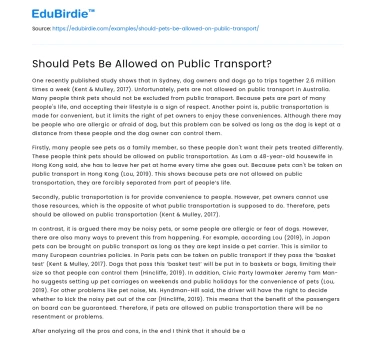One recently published study shows that In Sydney, dog owners and dogs go to trips together 2.6 million times a week (Kent & Mulley, 2017). Unfortunately, pets are not allowed on public transport in Australia. Many people think pets should not be excluded from public transport. Because pets are part of many people's life, and accepting their lifestyle is a sign of respect. Another point is, public transportation is made for convenient, but it limits the right of pet owners to enjoy these conveniences. Although there may be people who are allergic or afraid of dog, but this problem can be solved as long as the dog is kept at a distance from these people and the dog owner can control them.
Firstly, many people see pets as a family member, so these people don't want their pets treated differently. These people think pets should be allowed on public transportation. As Lam a 48-year-old housewife in Hong Kong said, she has to leave her pet at home every time she goes out. Because pets can't be taken on public transport in Hong Kong (Lou, 2019). This shows because pets are not allowed on public transportation, they are forcibly separated from part of people’s life.
Save your time!
We can take care of your essay
- Proper editing and formatting
- Free revision, title page, and bibliography
- Flexible prices and money-back guarantee
Secondly, public transportation is for provide convenience to people. However, pet owners cannot use those resources, which is the opposite of what public transportation is supposed to do. Therefore, pets should be allowed on public transportation (Kent & Mulley, 2017).
In contrast, it is argued there may be noisy pets, or some people are allergic or fear of dogs. However, there are also many ways to prevent this from happening. For example, according Lou (2019), in Japan pets can be brought on public transport as long as they are kept inside a pet carrier. This is similar to many European countries policies. In Paris pets can be taken on public transport if they pass the ‘basket test’ (Kent & Mulley, 2017). Dogs that pass this ‘basket test’ will be put in to baskets or bags, limiting their size so that people can control them (Hincliffe, 2019). In addition, Civic Party lawmaker Jeremy Tam Man-ho suggests setting up pet carriages on weekends and public holidays for the convenience of pets (Lou, 2019). For other problems like pet noise, Ms. Hyndman-Hill said, the driver will have the right to decide whether to kick the noisy pet out of the car (Hincliffe, 2019). This means that the benefit of the passengers on board can be guaranteed. Therefore, if pets are allowed on public transportation there will be no resentment or problems.
After analyzing all the pros and cons, in the end I think that it should be allowed to use public transport with pets.






 Stuck on your essay?
Stuck on your essay?

